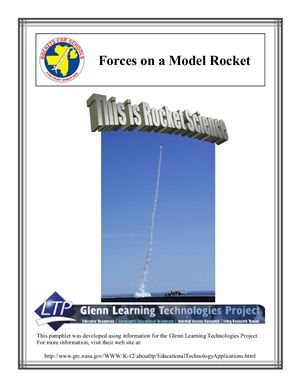NASA. Glenn Research Center, 13 pages.
Flying model rockets is a relatively inexpensive way for students to lea the basics of aerodynamic forces and the response of vehicles to exteal forces. Like an aircraft, a model rocket is subjected to the forces of weight, thrust, drag, and lift.
Separate slides show the forces acting on a model rocket during liftoff, powered flight, the coasting flight going upward and downward, and the final parachute recovery.
A model rocket rotates in flight about the center of gravity (the average location of the weight of the vehicle), just like any other flying object. It is easier to determine the center of gravity for a model rocket than for an aircraft. There are fewer components on a model rocket, and the geometry is much simpler than for an aircraft.
Forces on a model rocket
Newton`s first law applied to model rocket liftoff
Rocket thrust
The weight equation
Determining rocket weight
Determining center of gravity - cg
Shape effects on drag
The drag coefficient
Flying model rockets is a relatively inexpensive way for students to lea the basics of aerodynamic forces and the response of vehicles to exteal forces. Like an aircraft, a model rocket is subjected to the forces of weight, thrust, drag, and lift.
Separate slides show the forces acting on a model rocket during liftoff, powered flight, the coasting flight going upward and downward, and the final parachute recovery.
A model rocket rotates in flight about the center of gravity (the average location of the weight of the vehicle), just like any other flying object. It is easier to determine the center of gravity for a model rocket than for an aircraft. There are fewer components on a model rocket, and the geometry is much simpler than for an aircraft.
Forces on a model rocket
Newton`s first law applied to model rocket liftoff
Rocket thrust
The weight equation
Determining rocket weight
Determining center of gravity - cg
Shape effects on drag
The drag coefficient

